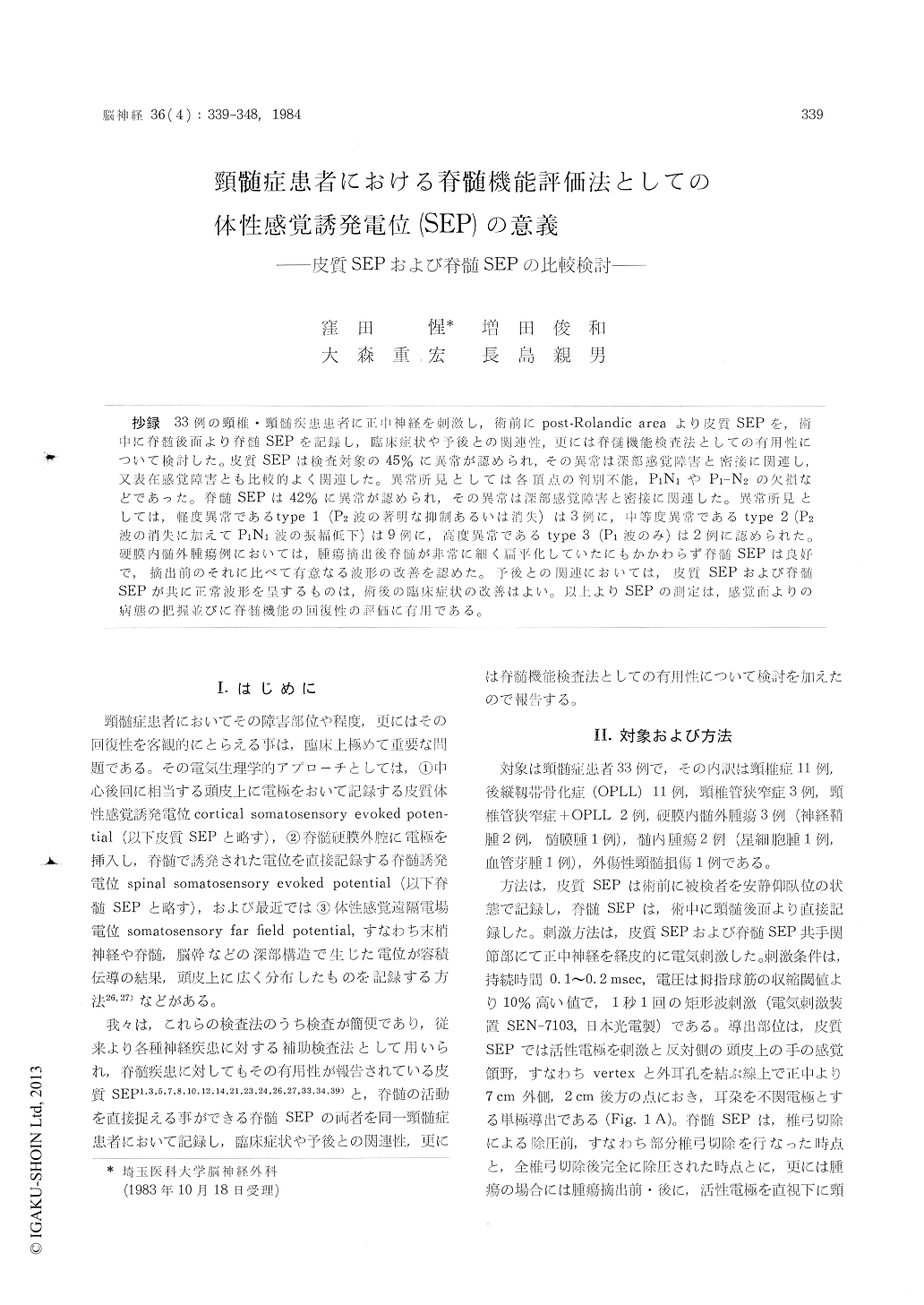Japanese
English
- 有料閲覧
- Abstract 文献概要
- 1ページ目 Look Inside
抄録 33例の頸椎・頸髄疾患患者に正中神経を刺激し,術前にpost-Rolandic areaより皮質SEPを,術中に脊髄後面より脊髄SEPを記録し,臨床症状や予後との関連性,更には脊髄機能検査法としての有用性について検討した。皮質SEPは検査対象の45%に異常が認められ,その異常は深部感覚障害と密接に関連し,又表在感覚障害とも比較的よく関連した。異常所見としては各頂点の判別不能,P1N1やP1—N2の欠損などであった。脊髄SEPは42%に異常が認められ,その異常は深部感覚障害と密接に関連した。異常所見としては,軽度異常であるtype 1(P2波の著明な抑制あるいは消失)は3例に,中等度異常であるtype 2(P2波の消失に加えてP1N1波の振幅低下)は9例に,高度異常であるtype 3(P1波のみ)は2例に認められた。硬膜内髄外腫瘍例においては,腫瘍摘出後脊髄が非常に細く扁平化していたにもかかわらず脊髄SEPは良好で,摘出前のそれに比べて有意なる波形の改善を認めた。予後との関連においては,皮質SEPおよび脊髄SEPが共に正常波形を呈するものは,術後の臨床症状の改善はよい。以上よりSEPの測定は,感覚面よりの病態の把握並びに脊髄機能の回復性の評価に有用である。
It is desirable for neurosurgeons to be able to evaluate cord functions. To assess electrophysiol-ogically functional status of spinal cord, cortical and spinal somatosensory evoked potentials (SEP) were studied in 33 patients with cervical radicu-lomyelopathy; 11 cases of cervical spondylosis, 11 cases of OPLL, 3 cases of narrow canal, 2 cases of narrow canal with OPLL, 3 cases of intradural extramedullary tumor, 2 cases of intramedullary tumor and one case of traumatic cervical cord injury.
Before the operation cortical SEP was recorded from post-Rolandic area by the median nerve stimulation. Spinal SEP was recorded from the dorsal surface of the cord after partial and com-plete laminectomy, or before and after tumor removal.
Results:
1) Cortical SEP showed abnormalities in 45% of the cases, whose abnormalities were disappear-ance of the early components such as P1N1 wave, P1 to P2 complex or P1 to P3 complex and delay of the peak latency.
2) Spinal SEP showed abnormalities in 42% of the cases, and the abnormal patterns were divided into 3 groups as follows: Type 1: Slightly abnormal, P1 and N1 waves are well recorded, whereas the P2 wave is absent or markedly su-pressed in the amplitude. Type 2: Moderately abnormal, the P2 wave is flat and in addition the N1 wave is diminished in the amplitude. Type 3: Severely abnormal, only the P1 wave is recorded and the N1 to P2 complex is absent. Type 1 was obtained from 3 patients, type 2 from 9 patients, and type 3 from 2 patients.
3) Cortical and spinal SEP were closely related to deep sensations, and cortical SEP was relatively correlated with superifical sensations.
4) There were no differences of spinal SEP in most of the cases between partial and complete laminectomy. In intradural extramedullary tumor, however, good spinal SEP was recorded in col-lapsed cord after the tumor removal.
5) Clinical symptoms were improved postopera-tively in 80% of patients with both normal cor-tical and spinal SEP.
It is concluded that cortical and spinal SEP are useful for prognostic value in patients with cer-vical radiculomyelopathy.

Copyright © 1984, Igaku-Shoin Ltd. All rights reserved.


